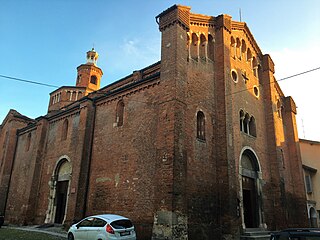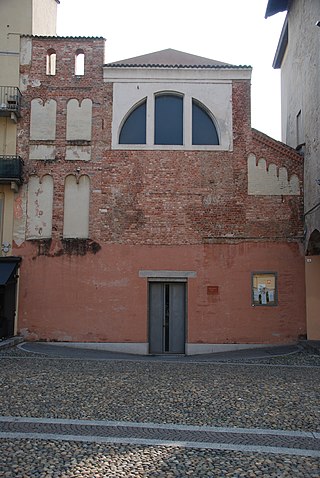
Pavia is a town and comune of south-western Lombardy, in Northern Italy, 35 kilometres south of Milan on the lower Ticino near its confluence with the Po. It has a population of c. 73,086. The city was the capital of the Ostrogothic Kingdom from 540 to 553, of the Kingdom of the Lombards from 572 to 774, of the Kingdom of Italy from 774 to 1024 and seat of the Visconti court from 1365 to 1413.

Rothari, of the house of Arodus, was king of the Lombards from 636 to 652; previously he had been duke of Brescia. He succeeded Arioald, who was an Arian like himself, and was one of the most energetic of Lombard kings. Fredegar relates that at the beginning of his reign he put to death many insubordinate nobles, and that in his efforts for peace he maintained very strict discipline.

San Pietro in Ciel d'Oro is a Catholic basilica of the Augustinians in Pavia, Italy, in the Lombardy region. Its name refers to the mosaics of gold leaf behind glass tesserae that decorates the ceiling of the apse. The plain exterior is of brick, with sandstone quoins and window framing. The paving of the church floor is now lower than the modern street level of Piazza San Pietro in Ciel d'Oro, which lies before its façade.

The Basilica of San Michele Maggiore is a Roman Catholic church in Pavia, region of Lombardy, Italy. The building, dating to the 11-12th centuries, is a well-preserved example of the Lombard-Romanesque style.

Santa Maria del Carmine is a church in Pavia, Lombardy, northern Italy, considered amongst the best examples of Lombard Gothic architecture. It was begun in 1374 by Gian Galeazzo Visconti, Duke of Milan, on a project attributed to Bernardo da Venezia. The construction followed a slow pace, and was restarted in 1432, being finished in 1461.

The Civic Museums of Pavia are a number of museums in Pavia, Lombardy, northern Italy. They are housed in the Castello Visconteo, or Visconti Castle, built in 1360 by Galeazzo II Visconti, soon after taking the city, a free city-state until then. The credited architect is Bartolino da Novara. The castle used to be the main residence of the Visconti family, while the political capital of the state was Milan. North of the castle a wide park was enclosed, also including the Certosa of Pavia, founded 1396 according to a vow of Gian Galeazzo Visconti, meant to be a sort of private chapel of the Visconti dynasty. The Battle of Pavia (1525), climax of the Italian Wars, took place inside the castle park.

San Teodoro is a Romanesque-style Roman Catholic church in the town center of Pavia, Italy.

Principality of Pavia was an historic division of the Duchy of Milan, which was ranked as a principality as an honor to the reigning House of Milan.

The Visconti Castle of Pavia is a medieval castle in Pavia, Lombardy, Northern Italy. It was built after 1360 in a few years by Galeazzo II Visconti, Lord of Milan, and used as a sovereign residence by him and his son Gian Galeazzo, first duke of Milan. Its wide dimensions induced Petrarch, who visited Pavia in the fall of 1365, to call it "an enormous palace in the citadel, a truly remarkable and costly structure". Adjacent to the castle, the Visconti created a vast walled park that reached the Certosa di Pavia, a Carthusian monastery founded in 1396 by the Visconti as well and located about 7 kilometres (4.3 mi) to the north.

Characteristic of the historic center of Pavia is the presence of medieval noble towers that survive in its urban fabric, despite having once been more numerous, as evidenced by the sixteenth-century representation of the city frescoed in the church of San Teodoro. They were mostly built between the 11th and 13th centuries when the Ghibelline city was at the height of its Romanesque flowering.

The church of San Francesco of Assisi is a Catholic religious building in Pavia, Lombardy, Italy.

The church of San Giovanni Domnarum is one of the oldest in Pavia. In the crypt, which was rediscovered after centuries in 1914, remains of frescoes are visible.

The Basilica of Santissimo Salvatore is a Roman Catholic church in Pavia, region of Lombardy, Italy. It was founded in 657 by the Lombard king Aripert I and became a mausoleum for many of the Lombard kings.

The church of Santa Maria in Betlem, founded around 1130, stands in the characteristic district of the Borgo of Pavia, located, after the Ponte Coperto, on the other bank of the Ticino river from the city center.

The monastery of San Felice was one of the main female Benedictine monasteries of Pavia; founded since the Lombard period, it was suppressed in the 18th century.Part of the church and the crypt survive from the original Lombard complex.

The church of San Marino is a Catholic church in Pavia, in Lombardy.

The Church of San Tommaso is a former Catholic church and monastery in the city of Pavia, Lombardy, Italy. It is located within the historic city center and belongs to the University of Pavia.

The monastery of Santa Maria Teodote, also known as Santa Maria della Pusterla, was one of the oldest and most important female monasteries in Pavia, Lombardy, now Italy. Founded in the seventh century, it stood in the place where the diocesan seminary is located and was suppressed in the eighteenth century.

The church Santa Maria Gualtieri is a deconsecrated church in Pavia now used for exhibitions, concerts and conferences.

The Church of Santi Gervasio e Protasio is a church in Pavia, in Lombardy.




















